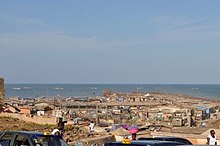Squatting in Ghana


Squatting in Ghana is the occupation of unused land or derelict buildings without the permission of the owner.
History
In Ghana, following British colonialism squatting occurred at a lower rate than in other countries both because of strong tribal control of land and because it is viewed in a negative light as it violates traditional views on indigenous property rights.[1][2] A rare example of squatting in the 1960s is Ashaiman, which was expanded by workers building the new city of Tema and is now a town of 100,000 people.[1][3] Another example is Adiembra at Kumasi.[1]
More recently, the poor are generally excluded from housing and employment opportunities, so they squat land on the edge of cities to live on and also occupy pavements and public areas in order to sell goods as hawkers.
In the capital Accra, in 2018 a shanty town was evicted to make way for the Marine Drive Project and the following year hundreds of squatters were evicted by the Ablekuma West Municipal Assembly (AWMA).[6][7]
Old Fadama

In informal settlements such as Old Fadama next to Agbogbloshie in central Accra, an informal economy has developed in which squatter landlords rent out places to live. The Accra Metropolitan Assembly (AMA) decided in the early 2010s to evict Old Fadama, where an estimated 80,000 people were living.[4] The site of 31.3 hectares had grown as a settlement from the 1990s onwards, housing both Ghanaian migrants fleeing conflict in the north and middle-class residents of Accra who lost their houses elsewhere. The settlement is mainly constructed of shacks without sanitation, and flooding from the nearby Odaw river occurs frequently.[5]
The proposed eviction became a controversial issue, with the AMA wanting to redevelop the land next to the
See also
References
- ^ .
- ISBN 978-1-316-51330-9.
- ^ United Nations Human Settlements Programme (2003). The Challenge of Slums: Global Report on Human Settlements, 2003. p. 82.
- ^ .
- ^ S2CID 255518500.
- ^ Staff writer (28 June 2018). "Kawukudi Squatters Cleared". Modern Ghana. Retrieved 19 March 2021.
- ^ NYARKO-YIRENKYI, ANITA (19 July 2019). "Squatters evicted from Shiabu slums at Dansoman". Ghanaian Times. Retrieved 19 March 2021.
Further reading
- Konadu-Agyemang, Kwadwo O. (February 1991). "Reflections on the Absence of Squatter Settlements in West African Cities: The Case of Kumasi, Ghana". Urban Studies. 28 (1): 139–151. S2CID 154621896.
